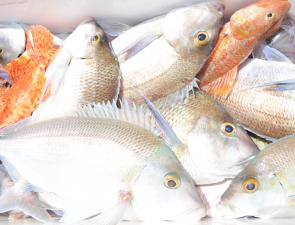Having grown up in the Bega district, the sounds of Summer to me are the cicadas, crickets and insect life buzzing around the banks of the river.
Proliferating insects will ensure that fish like bass, bream, mullet and estuary perch will start to intensively feed on insects.
The Bega River is a great place to fish, especially around the brackish regions where all these species are feeding.
Early morning or late afternoon when the cicadas are in full noise are prime times. Surface lures work well and those who like to cast a fly will find cicada imitations palmered and shaped from deer hair will work exceptionally well.
Further into the local estuaries, all likely species are on the chew.
Flathead are responding well to soft plastics and bait especially early in the morning after nights of prawn activity.
There are plenty of bream, luderick, whiting and mullet searching over the flats and they may respond to a lure and are happy to take a nipper, worm or fresh prawn.
As the sun sets you can often hear the distinct noise of prawns skipping across the surface. This is the time to ditch the fishing gear, grab the waders, lights and prawn nets and cash in on the numbers of prawns now available.
After having been closed to the sea for some 25 years, Wallagoot Lake, south of Tathra, opened during the big rains earlier in the year and should be a prime location for prawners.
Most beaches in the area are fishing well for whiting, which seem to be in very good numbers, along with bream and mullet.
As usual, schools of salmon are providing excellent sport.
Now the weather has warmed up, it’s prime time to target the beach at night for tailor, sharks (especially gummies and whalers) and the odd jewfish.
As the school holidays arrive, fishing activity will focus around Tathra Wharf.
Everyone loves catching slimy mackerel and there are plenty of them this season, along with yellowtail, plenty of trevally and, on the surface, garfish. You need only light gear for them, even a handline, small hooks and some bait to start off with.
The larger pelagic species have also returned and using some of these smaller yellowtail or mackerel as bait will put you in with a chance of a kingfish, bonito, small hammerhead shark or a salmon.
Frigate mackerel and striped tuna will take lures and towards dark you can expect to find tailor closer to the surface.
There are kingfish schools up and down the coast along with quite a lot of bonito and striped tuna.
Trolling is probably the best way of finding the fish and then you may wish to try jigs or bait.
Striped tuna are turning up anywhere from the shore to beyond the continental shelf, where you will also find albacore, yellowfin and the occasional big-eye tuna.
A spread of bibbed and skirted lures is the way to go to find these. Make sure you have at least one large skirted lure because there is always the likelihood of a billfish.
Another of the sounds of Summer is the north-east wind increasing in the afternoon. Most days you have a window early to mid-morning to go to sea and make the most of the reef and bottom fishing.
Morwong, snapper, pigfish, kingfish, ocean perch and sand and tiger flathead are in feeding mode right now – what are you waiting for?
Reads: 1817
There are plenty of bass in the Bega River. They like crankbaits but this month they’ll also be keyed in on surface lures.

A bag of tasty reef fish caught off Tathra – morwong, snapper, red rock cod and sergeant baker.

Tathra Wharf is a popular spot in Summer. Get there early to secure your favourite spot.




